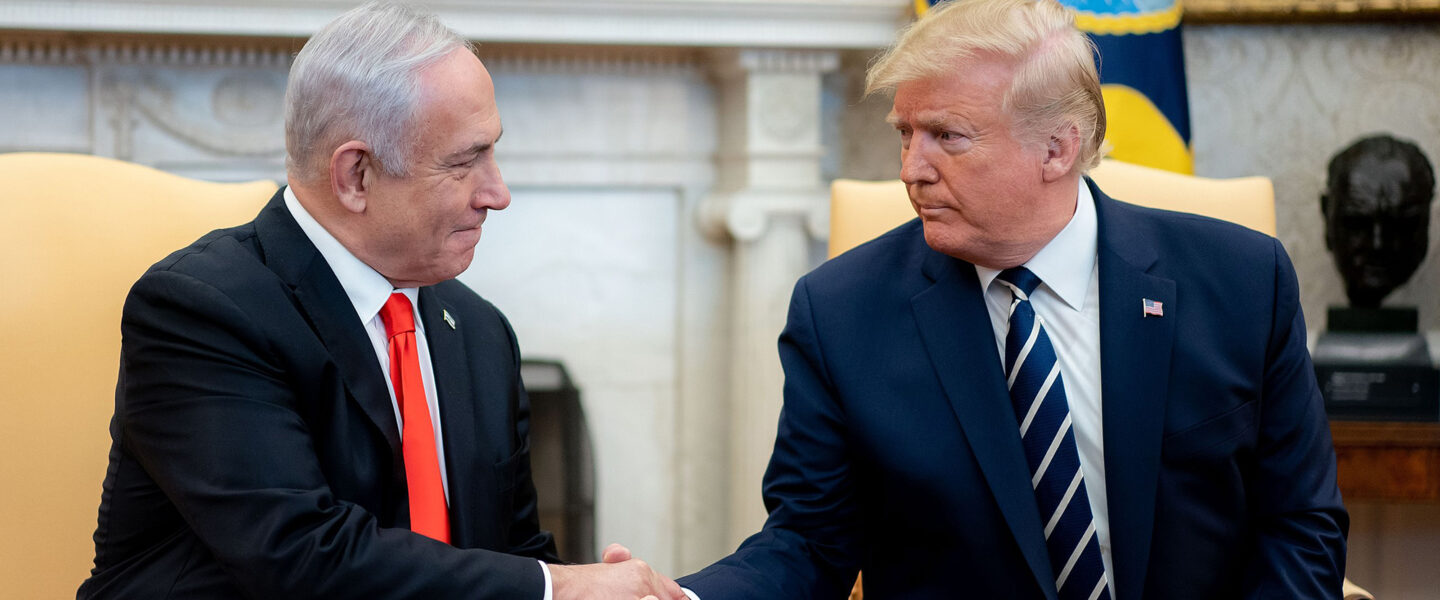Under fire for his global tariffs, Trump turns back to the Middle East. Tuesday’s meeting with Netanyahu could impact the current ceasefire and the fate of the Palestinians.
|
Listen To This Story
|
Donald Trump’s Oval Office could be Benjamin Netanyahu’s brick wall.
That is if the president uses Tuesday’s meeting with Netanyahu, the first foreign leader to visit Washington since Trump returned to office, to ensure a successful Israeli-Hamas negotiation of the Gaza ceasefire agreement’s second phase.
For that, Netanyahu and Trump would have to agree on who will administer the devastated Gaza when the guns permanently fall silent and Israeli troops withdraw entirely in the second phase.
Netanyahu has delayed sending negotiators to Doha, Qatar, for the second-phase negotiations, which were supposed to begin on Monday. He wants to wait until he has met with Trump to give his negotiators their marching orders.
Trump demonstrated his ability to bend Netanyahu to his will when he got the prime minister to accept the Gaza ceasefire in a matter of days after Netanyahu refused for eight months to agree to a cessation of hostilities on more or less the same terms.
Netanyahu has long insisted that ceasefires facilitate prisoner exchanges, but only the total destruction of Hamas can end the war.
Failing to have definitively defeated Hamas, Netanyahu has so far refused to spell out his vision of Gaza’s future beyond ruling out a role for either Hamas or the West Bank-based, internationally recognized Palestinian Authority and hinting at recruiting Gazan tribal and clan leaders instead.
Netanyahu’s failure has allowed him to prolong the Gaza war at an unconscionable human cost, particularly involving Palestinian lives, and extend the shelf life of his fragile governing coalition.
Netanyahu’s acceptance of the ceasefire’s first phase prompted ultranationalist National Security Minister Itamar Ben-Gvir to resign. The second-phase negotiations could spark the departure of hardline Finance Minister Bezalel Smotrich, and potentially the collapse of the government.
Hamas complicated things for Netanyahu by demonstrating this week its ability to maintain command and control, field a disciplined armed force, and choreograph the release of hostages abducted by the group and Islamic Jihad during their October 7, 2023, attack on Israel, despite having been severely battered for 15 months during Israel’s relentless assault on Gaza.
Adding fuel to the fire, Palestinians see the return of hundreds of thousands of displaced Gazans to their devastated homes in northern Gaza as having thwarted a perceived Israeli plan to cleanse the region ethnically.
Israel has acknowledged Hamas’s survival by negotiating a ceasefire with the group and agreeing to a security protocol that allows unarmed Hamas policemen to maintain law and order in designated areas except when carrying arms is deemed an absolute necessity.
Even so, Trump and Netanyahu will agree in their meeting that there is no place for Hamas in post-war Gaza.
However, the Palestinian Authority is likely to be in a different category. Trump’s Middle East envoy, Steve Witkoff, signaled there was a place for the official representative of the Palestinian people when he met in Saudi Arabia in recent days with Hussein al-Sheikh, the secretary general of the Palestine Liberation Organisation (PLO), the Palestinian Authority’s backbone.
It was the first meeting between a Trump administration official and the Authority since 2017, when the Authority boycotted Trump’s first administration for moving the US embassy from Tel Aviv to Jerusalem and recognizing Jerusalem as Israel’s capital.
To bridge the gap with Netanyahu, Trump could adopt a proposal for an interim international administration in Gaza that the Biden administration had discussed with the United Arab Emirates and Israel.
Under the proposal, the Authority, widely viewed as ineffective and corrupt, would initially be part of an international administration while it cleans up its act and its security forces are retrained and vetted to weed out elements sympathetic to armed militants on the West Bank and in Gaza.
The administration would employ private security companies to assist in enforcing law and order and training the Palestinian security forces.
Catering to Palestinian President Mahmoud Abbas’s insistence that the Authority is the entity legally entitled to govern Gaza, the Authority would formally invite the international partners, even though the ceasefire agreement made no mention of the Palestine Authority. In 2007, Hamas expelled from Gaza Abbas’s Fatah movement, the group’s archrival and the dominant force in the PLO and the Authority.
In recent months, Abbas has sought to demonstrate to Israel and Trump the Authority’s “reliability,” at the risk of further jeopardizing what little credibility it still had among Palestinians, by cracking down on militants in the Jenin refugee camp in between Israeli attacks on the settlement, and replacing an Israeli ban on Al Jazeera reporting from the West Bank with a prohibition of his own.
Hamas’s show of strength during the prisoner releases highlights the group’s ability to disrupt a transition in Gaza if a post-war administration fails to recognize the group in a mutually acceptable fashion.
Hamas and Fatah have discussed forming an administration of politically independent technocrats nominated by both groups that would govern Gaza and the West Bank.
A technocratic government may encourage donors to help Gaza get essential services back on track, but investors will need more to convince them that pumping billions into Gaza’s reconstruction is not pouring money into a black hole of cyclical violence.
To create that kind of confidence, Trump will have to do some serious arm-twisting when he meets Netanyahu on Tuesday.
The president got off to a wrong start with his call for the resettlement in Egypt and Jordan of Gazan Palestinians. Rejected by Arab foreign ministers, the call sent Netanyahu the wrong message on the eve of his meeting with the president.
Diplomats and analysts say that is easily corrected.
“I would like to see the Palestinian Authority and other countries enter Gaza and rehabilitate it. There is a readiness to put boots on the ground and pour money into Gaza, provided there is a political horizon for the resolution of the Israeli-Palestinian conflict. This has to be a two-state solution. That’s where President Trump has a lot to say,” said former Israeli justice minister and peace negotiator Yossi Beilin.
Unfortunately, it emerged at the press conference following Trump’s meeting with Netanyahu that the president had plenty to say and none of it in that direction. Although he provided few details, Trump made it clear his plan was for the US to take over Gaza, quite literally own it, drive out the Palestinians (“Why would they want to return? The place has been hell,” Trump said. Well yes, after 15 months of Israeli bombing, it’s hard to argue with that assessment.), and “do something really nice, really good” with it, make it “the Riviera of the Middle East.”
A smiling Netanyahu, whom Trump praised lavishly, returned the compliment, telling the president, “You are the greatest friend Israel has ever had in the White House.” Palestinians and their supporters were, understandably, less enthusiastic.
James M. Dorsey is an Adjunct Senior Fellow at Nanyang Technological University’s S. Rajaratnam School of International Studies, and the author of the syndicated column and podcast The Turbulent World with James M. Dorsey.




